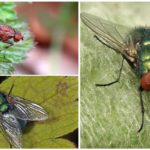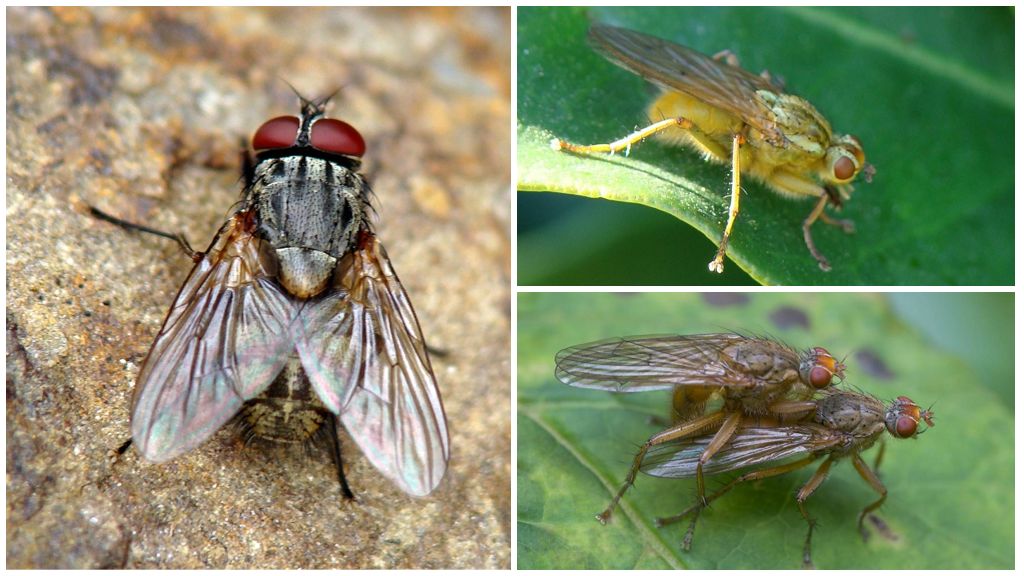Description and photo of manure fly
Content
- Dung fly
- Dung fly
Manure flies, dung beetles, scathophages or scatophagids are representatives of the order of dipterans of the family Skatophagidae. Many people represent them as brilliant green insects swarming in manure. However, this form have green carnal flies. The dung fly looks much more attractive. On the features of dung, its nutrition and habitat, this article will tell.
What it looks like
Fuck - Red fly size no more than 1-1.5 cm. The cylindrical form of the body is covered with a thick gray or reddish nap, which in appearance resembles a kind of "fur".On the small head there are clearly visible large, wide-set eyes that have a reddish-brown tint, as well as antennae of the antenna. At the base of the wing, only one scale is well developed. On the front limbs of the insect there are long spikes, thanks to which it keeps its prey when it is captured (the photo of a dun flies is presented below).
Where dwells
About half a thousand species of dung are known to science, most of which inhabit the Palearctic, North America, and Mexico. Together with livestock insects were trapped in Brazil and South Africa. Up to two dozen species of these insects inhabit the territory of the Russian Federation.
On a note!
The dung fly is a lover of moisture: it can be found in lowland forests, mountain meadows, coastal vegetation, in swamps, peatlands and even in the southern tundra.
What feeds on
The fly dung is a predator. Power source Invertebrate organisms serve. It attacks other insects, including flies, holding its prey with its front paws and destroying it with a lightning bite of its powerful jaws. Often the size of the victim exceeds the size of the predator itself.
About reproduction
It is almost impossible to meet insects in human housing due to the lack of suitable food in it. But quite often "mohnatik" can be found in the premises where livestock are kept. There dung flock to find a mate: the male is waiting for his partner on the dunghill. Females also lay eggs in livestock manure, from which after a day the larvae appear.
The greatest preference is given to dung flies by the dung of pigs and calves that feed on milk, since their feces, unlike those of horses, retain the necessary temperature longer. Having laid eggs, females go to the world of flowering plants to feast on another victim. And the newly formed larvae continue to develop in the compost heap.
Most of the larvae are phytophagous, however, both saprophagous animals and predators are found. Phytophages develop in the stalks of rush, sorrel, and sedges; they also give preference to the plants of the lily and reed family. Often, rye ears also suffer from the attacks of gluttonous larvae.
What harm does a person fly dung
Despite the fact that the dung crawling on the manure and can be carriers of pathogenic bacteria, they do not represent any special harm to humans.After all, they infiltrate people's housing in rare cases, and besides bites they do not commit.
However, living in a barn that contains cattle, insects are able to very quickly breed. As a result, the presence of dung that climb into the eyes and ears of animals, gives the last great discomfort. For this reason, farmers are trying to control the number of annoying insects in animal rooms.
On a note!
No less dangerous dung flies can be for garden and garden plants, or rather the larvae that have emerged from the eggs. Constructing tunnels for their movement, they cause great damage to the leaves of plants, which often causes them to wilt.
To get rid of flies, it is necessary to clean the manure in pens in a timely manner and remove the affected leaves. Ideal - the cultivation of plants under the mosquito net, which will protect young seedlings from the penetration of manure flies. It is also possible to control harmful insects in the shed. sticky tape or traps with bait. To prevent the penetration of scatophages, you can also use bay oil,who need to handle the window and door openings of the premises. You can also make self adhesive tapes.









